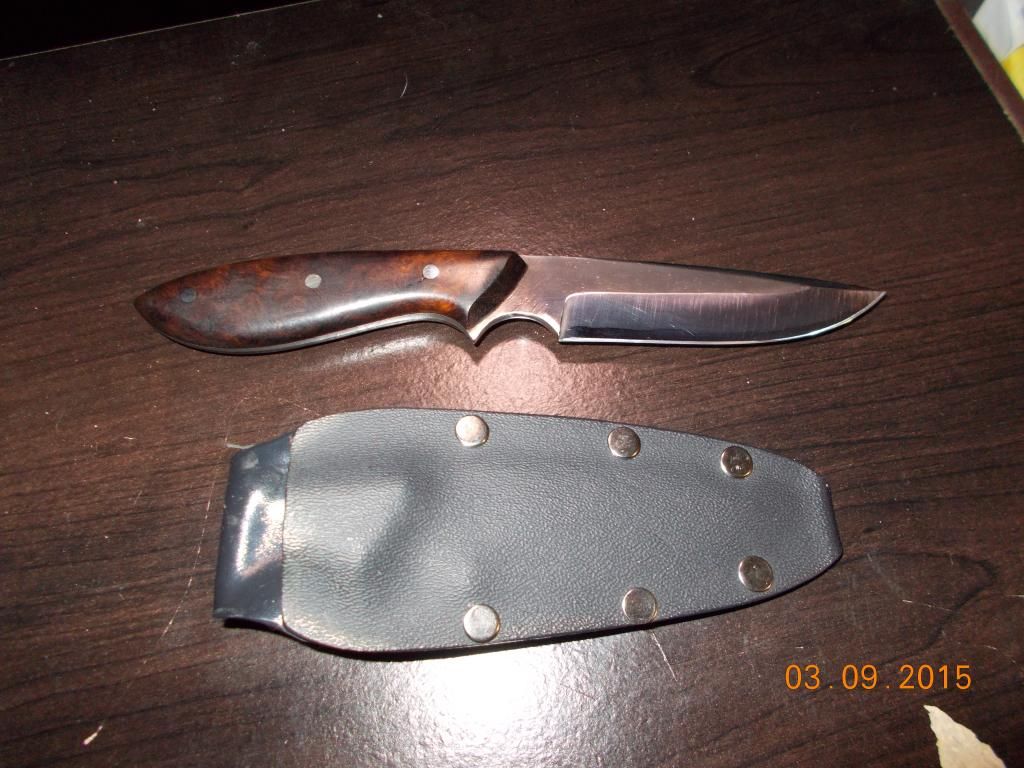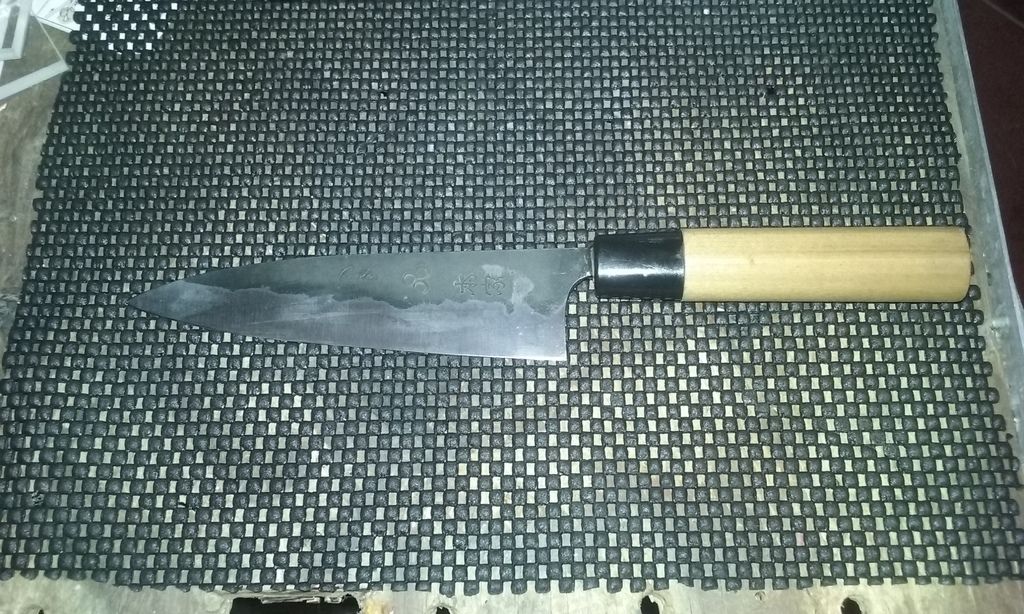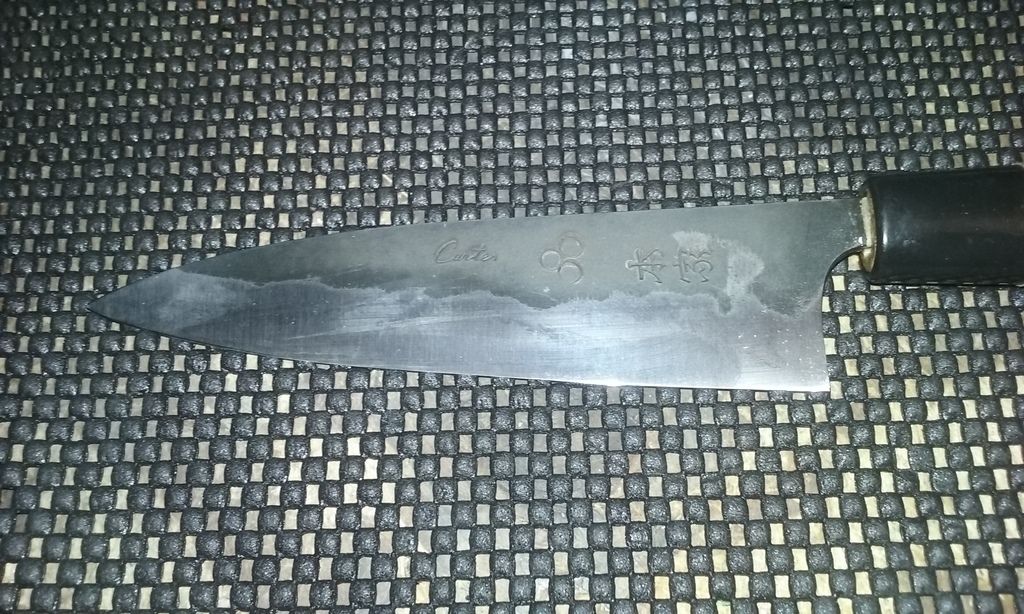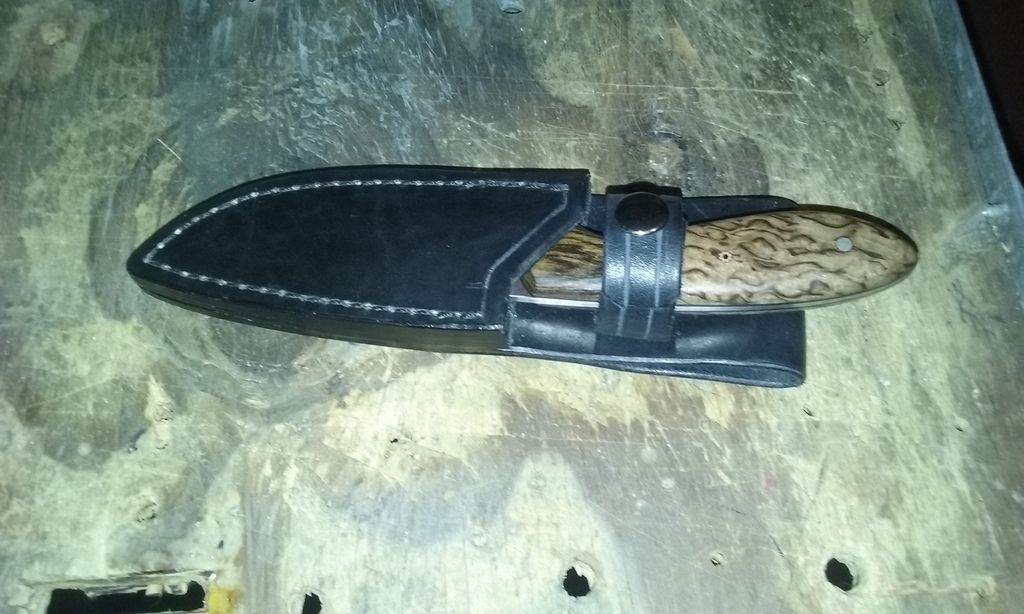iKnife Collector
The online community of knife collectors, A Knife Family Forged in Steel
Carter Cutlery neck knives (original and Muteki)
I finally got a Carter neck knife. First I got a “Muteki” neck knife. The Muteki (means without rival) knives are made by an apprentice of Murray Carter’s who he has been teaching. They are made of the same blade steel (Hitachi white steel) and materials. They are less expensive than the ones Murray Makes. I got that one but then in his emails you can sign up for he offered a free Kuro-uchi kitchen knife with a purchase of a Carter knife (not Muteki). So I then ordered an original Carter neck knife. About a week ago I got the free kitchen knife. It’s the first high quality kitchen knife I’ve had. I haven’t used it and I don’t know what the wife thinks yet. It is very thin and very sharp so I’m sure it’s a joy to use. Anyway, here are a few comments on the neck knives I got.
I only used the Muteki for about one week. After I got the original Carter knife I’ve been using it. I have been carrying a small folder in a neck sheath and absolutely love that way to carry a knife. It provides the easiest access to a knife there is IMO. Not the best method for all attire however. I’m retired and never (almost) dress nice any more so that’s not an issue. But in some areas a knife carried out in the open like that make non-knife people think you a re a serial killer. I wasn’t sure how I’d like carrying a fixed blade which is a bit bigger than the Spyderco Dragonfly 2 but it’s a matter of getting use to. I’m very used to it now. Normally I put it under my shirt when I go anywhere but I went to Winn Dixie the other day and forgot about it. The cashier said “I like your necklace”. Lol When I ordered the Muteki I also ordered an additional belt sheath. It holds both knives although it holds the Muteki better. The sheaths are Kydex and formed for the knife they are sold with. There is no chance (within reason) of the knives falling out of the sheaths.
About the knife. The blades are all hand forged and not cut from a sheet of steel like production knives. Carter knives are a core in the center of Hitachi white steel with stainless steel on both sides. The core is supposed to be at a Rockwell hardness of 64-65. It is not hard to sharpen though. ZDP-189 has a similar hardness and is much more resistant to grinding. Takes longer to sharpen it. But to really understand about this requires more knowledge about metallurgy than I have. All I know is how easy or hard a blade steel is for me to sharpen then how long does it holds that edge. The white steel is excellent in that it’s not difficult to sharpen and holds an edge VERY well. The only testing I do other than just every day use is I will cut up a bunch of cardboard. The Carter neck knives hold the edge very, very well. The knives have full tang handles meaning the steel can be seen around the entire handle with the handle scales attached to the sides. The scales are attached with glue and pins. The original knife has a decorative pin in the center of the handle. One thing about these knives is since every one is hand made every one is one of a kind. That only means anything if it means something to the owner. I like it though. The handle on the original is birch and bocote wood separated with liners. The Muteki knife has an AZ desert ironwood handle. Both knives are pretty much the same as far as I can tell except for small things. The original knife has the appearance of one made by a master. The Muteki has the appearance of being made by a very skilled knife maker. I can’t tell any difference when using them. They are both outstanding knives. To be honest I wasn’t going to get the original because of the cost but when a Carter kitchen knife was offered with it for free I went ahead and got one. My plan was to sell the Muteki knife and maybe the kitchen knife to get back some of the money but so far I haven’t tried to sell either. The Muteki was not ground as thin as the original knife. More on the blade grind in a minute. This doesn’t mean anything IMO other than it’s just a choice of the knife maker. In fact I like that fact because it has given me some extra steel to play with. I have re-ground the Muteki secondary edge and polished it. More on the terminology Murray uses in a minute also. Both knives are an absolute joy to use. I don’t worry about edge retention because I don’t use a knife any more enough for them to get dull. With about two minutes every 2 or 3 days I can keep them hair whittling sharp. I think as far as being able to sharpen them you need good stones in good shape. I had a couple of Arkansas stones for about 15 years and I didn’t know how to take care of them. I’d use them with oil, wipe them off a little and that’s it. I’m sure they got and stayed clogged for a long time. I can’t find them now. I wish I could so I could flatten them and use them. Anyway, without much difficulty I can get these knives sharp enough to pop hairs off my arm like a straight razor just honed. As far as whittling a hair goes my hands are not as steady as they used to be so I generally just cut it in two. But if I try enough times I’ll luck out and whittle little slivers of a strand of hair.
Both knives are super comfortable to use even when cutting a small branch or harder tasks. No hot spots that make my hand sore.
BLADE GRINDS
Since I got interested in knives I’ve noticed different people have different terminology when describing parts and grinds of a knife blade. The grinds I’ve gotten used to are saber, hollow, full flat grind. Sometimes I’ve seen knives that have a convex (rounded) grind on the blades. Mostly kitchen cutlery I think. Then the edge can be talked about with different words like “edge bevel”, “back bevel”, “primary edge”, “secondary edge”, “cutting edge”, etc. As long as we know what the writer or speaker is talking about the terminology can be different. Here is how Murray refers to parts of the neck knife blades. Three parts. The “primary edge” is the cutting edge. The “secondary edge” refers to most of the knife blade. Then there is the spine. I have always considered only the top of the blade the spine. The top, not any part of the sides. But I think Murray considers the top portion of the blade the spine including a small area of the sides. On these knives you sharpen the primary edge when they need a touch up. Once in a blue moon when the primary edge has enough steel removes that it is into the secondary edge and the blade is getting thicker you need to grind on the secondary edge to “thin” the blade. This is all there is to it. The grind is actually like the saber grind knives I’ve seen except on the saber grind knives I’ve seen the line at the top of the grind is not as high on the blade as a Carter knife. I would post a picture of this but I don’t have a saber grind knife right now. The grind on these knives results in a blade that gets thicker faster than a hollow grind which has a concave shape to it. I don’t know if you can hand forge a hollow grind knife.
The exposed white steel, being a carbon steel take a patina easily. At first I let if form by use. I used mine as a dinner knife once and the front half of the edge formed a patina almost immediately. Since then I put the blades in vinegar to patina the entire area of the exposed white steel because it’s said a patina helps protect the steel from corrosion. This is another area I’m not an expert in. The patina is a corrosion in itself. I look at it as patina is a good corrosion that protects the steel from bad corrosion (rust). Either way I plan to keep the knife clean which is the best corrosion protection I guess. I took the Muteki fishing one day and while I loved using it I was worried about using it. I wasn’t in a boat so not too much to worry about but I doubt if I’ll take these fishing in a boat. I’d hate to drop it and (in slow motion) watch it fall into the water. If that did happen I’m pretty sure I immediately find out how deep the water is right there. Lol
Summary:
These are simply great knives. Being fixed blades, which I’ve never carried as an EDC knife before, I don’t worry about anything getting inside the pivot or using the knife hard enough to damage a pivot or lock. Having said that though I think a folder is still a better choice for me. If I were a lumberjack though a fixed blade would be better because even though some folders now are very, very strong none are as strong as a fixed blade with a full tang.
Pictures. You can see the patina on the exposed white steel along the edge.


Muteki with belt sheath

Kuro-Uchi kitchen knife


Here is a leather sheath a very generous guy made from the Spyderco forum.

Jack
Tags:
Replies to This Discussion
-
Permalink Reply by Lars on April 15, 2015 at 21:24
-
Excellent write up Jack - any very good looking knives! I really appreciate your summary observations, as I am just the opposite - I prefer a fixed blade EDC over a folder. Can't say why for certain, I just always have.
Good stuff - thanks for posting!
-
-
Permalink Reply by Jack Haskins, Jr. on April 16, 2015 at 10:44
-
Sometimes the things we like but don't know exactly why are the best. I got a Spyderco worker (spring run) a few months ago and for some reason I really love carrying that knife. The blade steel (VG-10), handle (G-10), etc. are great but not what I'd call my favorites. But the knife as a whole I love. And I can't put my finger on why. So I just use it and don't worry about it. I'm also comming around to an EDC fixed blade. It's just so easy to keep clean even if I were to drop it in a mud hole. lol A folder would require more effort and I might opt for disassembling it to clean if it is a screw assembled knife. Most of my folders can be disassembled which I love. Don't do it often for cleaning but sometimes I get a wild hair and make scales for the handle.
Lars Ray said:Excellent write up Jack - any very good looking knives! I really appreciate your summary observations, as I am just the opposite - I prefer a fixed blade EDC over a folder. Can't say why for certain, I just always have.
Good stuff - thanks for posting!
-
-
Permalink Reply by John Bamford on April 16, 2015 at 11:49
-
Great knives jack and a great review of them .
-
-
Permalink Reply by Alexander Noot on April 17, 2015 at 1:27
-
Those are nice. I love thinly ground knives myself. I'm more of a flat ground guy though. But those two look nice. I'd love to play around with a Carter knife sometime. I've read a couple of Carter's books and really do like em. He's got a very no-nonsense approach to knifemaking in general.
-
Latest Activity
© 2026 Created by Jan Carter.
Powered by
![]()